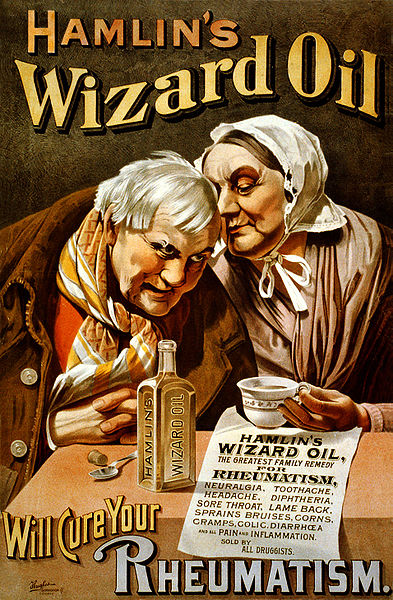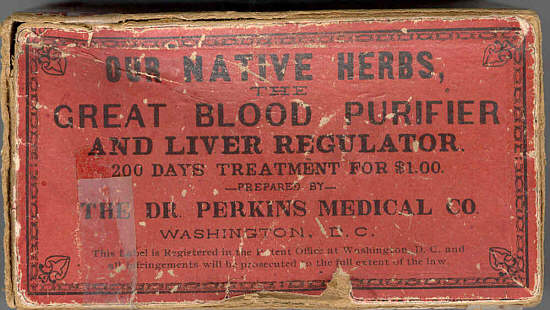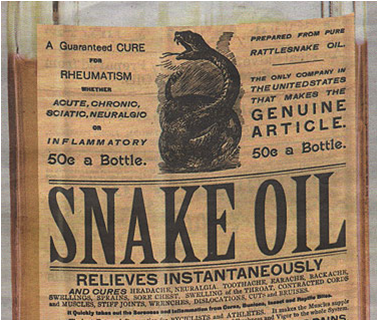Apr 08 2013
What Was in Patent Medicines
 What was actually in Thompson’s Cattle Powder, Hostetter’s Stomach Bitters, or Hamlin’s Wizard Oil?
What was actually in Thompson’s Cattle Powder, Hostetter’s Stomach Bitters, or Hamlin’s Wizard Oil?
Prior to regulation by the FDA, over-the-counter medicine in this country was largely a creation of small businesses. There was a large variety of so-called “patent medicine,” each a proprietary blend of – what?
The term “patent medicine” has nothing to do with being issued a patent. The term refers to a letters patent, which is essentially permission to use a royal endorsement. Most patent medicines were not actually patented mainly because the promoters did not want to disclose their ingredients.
Instead, such products were branded and their brand heavily marketed.
As a result the ingredients of these patent medicine products were largely unknown. Compounding pharmacists were familiar with the ingredients, however, and often sold cheap knockoffs, making it all the more important for promoters to protect and promote their brand.
A study presented recently at a meeting of the American Chemical Society reports the analysis of 50 different patent medicine from a collection in the Henry Ford Museum in Dearborn Mich. The results will probably not surprise you:
“Many patent medicines had dangerous ingredients, not just potentially toxic substances like arsenic, mercury and lead, but cocaine, heroin and high concentrations of alcohol.”
The heavy metals were likely largely contaminants, but sometimes they may have been deliberate. Mercury and arsenic, for example, were used at the time as treatments for syphilis. The other common ingredients were often the true active ingredients. Heroin is a narcotic and would have been effective at treating pain. Cocaine is an addictive substance – which makes it good for repeat business. And alcohol is could certainly take the edge off of many complaints, at least in the short term.
Ingredients were largely not advertised, although sometimes a main ingredient like heroin was part of the promotion. Often the implication given was that a special blend of natural herbs were the main ingredients, but that was just for show.
None of these products were the result of careful research. The manufacturers had no need for such expenses. They were motivated to make grandiose claims, promote their brands, to include cheap ingredients, and to include an ingredient that would give a good “kick” to their customers so that they would feel it was working.
While we may look back at such products as quaint and hokey, there is essentially no difference between them and the supplements that are all the rage today. After the 1994 Dietary Supplement Health and Education Act that essentially removed supplements from FDA regulation, we have had a return of the patent medicine era.
Today you can find countless products, heavily branded and marketed, with grandiose claims, often cut with something like caffeine or another legal stimulant to give a nice kick, and marketed without the need to provide any evidence for safety or efficacy.
 There are two main differences, however. The first is that the ingredients need to be disclosed. The second is that promoters cannot claim to cure diseases, but have to restrict their claims to “structure function” claims. This is a massive loophole, however, as they can make claims that their product supports some biological function with the clear implication of what it is treating.
There are two main differences, however. The first is that the ingredients need to be disclosed. The second is that promoters cannot claim to cure diseases, but have to restrict their claims to “structure function” claims. This is a massive loophole, however, as they can make claims that their product supports some biological function with the clear implication of what it is treating.
Airborne is a great example. This is heavily brand marketed, with the notion that it was created by a school teacher, as if that is a credible source for a medicine. The claim is that it will support your immune system, so take it before you get on a plane to prevent contracting a cold or other infection from all the close contact. In reality it’s just a mixture of vitamins and minerals, and there is no reason to think that it will support the immune system to prevent colds.
Today anyone can combine a random mixture of cheap ingredients – herbs, vitamins, or minerals – and then imply whatever health claims they wish for their mixture as long as they are slightly careful in how they word the claims.
This is a simple result of market forces in the absence of effective regulation. There is no reason to think that the snake oil herbs and supplements of today would be any different from that patent medicines of previous centuries.







